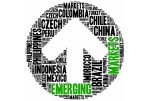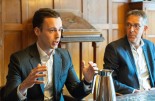Round table Emerging Market Debt: complex but promising
Round table Emerging Market Debt: complex but promising

This report was originally written in Dutch. This is an English translation.
Over the past ten to fifteen years, the EMD market has undergone a clear shift from hard currencies to local currencies. Government bonds denominated in hard currencies have historically exhibited a riskier profile than government bonds denominated in local currencies. EMD offers opportunities for investors who know how to strategically balance risk, sustainability and return.
By Hans Amesz
|
Moderator Harry Geels, Auréus
Participants Rob Drijkoningen, Neuberger Berman Asbjörn Friederich, Nuveen Naki Nartey, PIMCO Raymond van Wersch, PGGM |
How big is the EMD market now, both in local and hard currencies? Has it grown in recent years? If so, why?
Rob Drijkoningen: 'The EMD market is worth around $42 trillion and is growing by an average of 14% per year. These figures come from Bank of America.
Of course, there are varying figures, but most of the growth comes from local currencies and longer-term corporate bonds. External debt is more limited, but that is what people usually refer to when they talk about emerging market debt, i.e. mainly hard currencies such as dollars. Local debt remains somewhat underexposed.'
Naki Nartey: 'What is interesting about emerging markets is that most of the market is off-benchmark. There is $42 trillion in bonds outstanding, but the local debt that qualifies as a benchmark is around $5 trillion, and hard currency $1 trillion. Corporate debt is another $1 trillion. Unlike developed markets, the vast majority of these bonds are therefore not included in the official indices. This makes the opportunities for active managers more interesting, given their ability to invest off-benchmark.'
Drijkoningen: 'Many issues come from specific countries, particularly China. China has the largest share both locally and externally. At country level, there are restrictions on how much a country can issue in benchmarks. So a lot of issuance is simply not possible there. In addition, much of it is onshore, i.e. locally financed. In the past, emerging markets did not have good local yield curves, which meant they had to borrow in dollars. That created currency risks. Nowadays, you see a natural shift towards local issues, especially in China and India.'
Raymond van Wersch: 'Over the past ten to fifteen years, we have seen a clear shift from hard currencies to local currencies. Government bonds in hard currencies have historically had a riskier profile than government bonds in local currencies.'
Nartey: 'That depends on how you define risk. Local currencies offer better credit quality on average, but also more volatility due to the currency component. Hard currencies have lower credit quality on average, with more high-yield issuers. But if the currency risk is removed, you only take spread and credit risks, which are generally less volatile than FX.'
Drijkoningen: 'The local currency index, for example the Government Bond Index – Emerging Markets, the GBI-EM, only includes 18 to 20 countries, while the hard currency index, for example the Emerging Markets Bond Index, the EMBI, includes more than 70. But that does not reflect the underlying market of local currencies, which is much broader. Many countries and currencies are simply not eligible for the benchmark because they are not liquid enough. In hard currencies, you see the opposite: many names for a smaller underlying market. Of the approximately 72 countries in the EMBIGD, 27% represent around 80% of the weights. So it is fairly concentrated. If you diversify beyond the benchmark, you can generate alpha without necessarily taking on more risk.'
A few years ago, we often talked about frontier markets. You hardly hear that term anymore. Have those markets disappeared?
Drijkoningen: 'No, they still exist. There is one important difference, though: in hard currency, frontier countries are often already represented in the EMBI Global and NEXGEM benchmarks, while in local currency they are largely complementary because liquidity is often too low to be included in the standard index for EMD, such as the GBI–EM.'
Van Wersch: 'If you really want to make an impact, for example in the area of sustainability or transition, it helps to invest in frontier markets. Especially through local currencies, because that helps governments the most. We are investigating whether frontier markets can become a separate subset within our allocation to EMD local currencies.'
Nartey: 'We include frontier exposure in our global EMD portfolios, in both hard and local currencies where possible. We are even seeing more and more clients asking for a dedicated frontier portfolio, often for ESG or impact reasons. There are interesting opportunities in these markets, partly because returns there have been good recently.'
Drijkoningen: 'Yes, frontier local via the FTSE index is performing much better than the regular local currency index: around 5% more per year since 2017. It is a good diversifier and alternative source of returns. We use it both opportunistically and in a mandate against a frontier benchmark.'
Friederich: 'We do the same and have frontier exposure in both hard and local currencies, but in general we maintain diversified exposure to avoid blow-up risks.'
Van Wersch: 'Our own research data confirms that frontier markets in local currency outperform regular EM local. An index is now being launched that reflects this. Moreover, the maximum drawdown in frontier markets during crisis years is often lower than in regular emerging markets, also due to the general absence of large investors in frontier markets. It could therefore be an interesting diversification.'
What is the typical risk/return profile of local currency debt?
Drijkoningen: 'It is certainly riskier than hard currency debt in terms of volatility. In local currencies, you can limit risks by financing in euros instead of dollars, for example, which reduces volatility. This is particularly true if you choose currencies with low correlation.'
Friederich: 'That's right. In general, the biggest drawdowns in local benchmarks are due to the FX component, especially for dollar portfolios. If you finance in euros, you reduce that risk considerably and the picture becomes more attractive.'
Nartey: 'With local currencies, FX is the most volatile component, and then you also have local duration. With hard currencies, there is usually dollar duration and spread risk. Obviously, the FX component is the most volatile, the dominant risk factor. If you look at it from the perspective of euros or pounds, local currencies often look better because the dollar has strengthened over the past ten years.'
Van Wersch: 'We have chosen to invest exclusively in local currencies because government bonds in hard currencies are too similar to US dollar high yield and EM corporates in hard currencies. That is why we believe that local government bonds offer us better diversification. Last year, 2024, was not a good year for local currencies, but valuations are becoming increasingly attractive and local currency government bonds could benefit from a weaker US dollar.'
How do you deal with currency volatility?
Drijkoningen: 'You can hedge some of that volatility, for example through currency hedging. However, when interest rates are much higher than in the US, you give up much of the interest rate advantage, so that is not a permanent option. Now that US interest rates are higher, while countries such as China have very low yields of around 2%, hedging is becoming attractive. So the picture is nuanced. Strategic hedging can make sense, with room to deviate from it tactically.'
Nartey: 'We calibrate the size of positions with their volatility. If we find two currencies equally attractive, but one is more volatile, it will be given a smaller position in portfolios. This keeps the risk manageable.'
Volatility can be treacherous. Some currencies appear stable until they suddenly start to move sharply.
Drijkoningen: 'Volatility can be treacherous. Some currencies appear stable until they suddenly start to move sharply. Egypt is a classic example of this, Nigeria another. After a devaluation, you lose a lot. That's why you shouldn't just look at historical volatility, but also at implied volatility, as priced in the forwards.'
Nartey: 'I agree. We use implied volatility as part of our process.'
China is now the biggest player in the EMD market. How do you see China's role now and in the future?
Nartey: 'At the moment, we are quite bearish on China, both locally and in hard currency. The reasons for this are, first, low returns, which create better opportunities elsewhere. Second, the relationship between China and the United States is quite tense and could deteriorate further. Third, China has become less important for EM growth than in the past. In the past, when China grew, EM countries grew with it and vice versa. Over the past two years, we have seen China's growth slow down, but growth in emerging markets has actually been quite robust.'
Drijkoningen: 'We do have to distinguish between bonds in USD and those in local currencies. We are also underweight in the Chinese currency. But if you hedge the bonds against the dollar, you get about 3% extra. Then it's not a bad investment. The domestic market remains huge. State-owned companies in particular remain active. There is also a lot of innovation, for example in batteries, electric vehicles and technology. That's not going to disappear overnight.'
Friederich: 'The problem with Chinese corporate bonds is that there is little transparency regarding credit quality. We are significantly underweight in China, except for a few specific strong companies that mainly produce for the United States. These corporate bonds offer a Chinese 'postcode premium” compared to comparable US companies. We are seeing increasing demand for EM funds without China, i.e. ex-China benchmarks.'
If you manage a portfolio, do you recommend a broad mandate that includes everything (local, hard currency, frontier, corporates) or separate mandates for each segment? And should that be active or passive?
Van Wersch: 'We have just implemented a global credit strategy with three dimensions: return, risk and sustainability. We combine investment grade corporates and high yield corporates in developed and emerging markets. So we have a global credit mandate that we allocate to internal and external investment teams. With investment grade, you can focus on labelled bonds, while with high yield we focus on engagement with issuers and try to make them more transparent. The energy transition is largely taking place via EM corporates. There are many opportunities there. We have a separate mandate for government bonds in emerging markets, in local currency. We do not combine this with corporates in emerging countries, because that asset class has different risk characteristics and it is also more difficult to engage with governments than with companies.'
Is this global credit strategy, with a portfolio for emerging and developed markets, split into investment grade and high yield, unusual?
Van Wersch: 'We think so. Most investors still think in terms of so-called silos, in investment grade or high yield in developed and emerging markets. We believe in combining these asset classes into a single integrated mandate. This allows you to create the largest possible universe in which the 3D balance between return, risk and sustainability can be optimally achieved.'
The problem with Chinese corporate bonds is that there is little transparency regarding credit quality.
Nartey: 'We offer both separate mandates (local or hard currency) and blended strategies. ESG variants are also available. In separate mandates for hard currency, we often include corporates because they can add value, even if they are not in the benchmark. Of course, they often entail risks, but these can turn out to be advantageous.'
Friederich: 'Our philosophy is that it is difficult to manage local and hard currencies well together in a single fund. Research shows that blended funds often perform less well than hard currency-only funds. That is why we prefer a separate fund for both hard currency and local currency. However, we do add corporates to hard currency funds if this offers a better risk/return ratio. For example, in countries where spreads on government bonds are low, but corporate bonds offer attractive spreads.'
Drijkoningen: 'In practice, you see that if EMDs make up a small part of the total portfolio, investors prefer a blended mandate because it is simply easier. However, you do have to demonstrate that this approach adds value. Blended portfolios are often better diversified. Moreover, a blended mandate makes it easier to reallocate risk budgets between, for example, an attractive local currency and a less attractive hard currency in the same country.'
Blended portfolios have many sources of alpha. Can a manager oversee all of that?
Drijkoningen: 'Transparency is important. You need to be able to explain clearly where the risk comes from and where the performance is generated. Whether this is done adequately depends on the organisation. With blended strategies, you often see larger teams with a clear division of tasks. You can also do it with a small team, but then the coverage is more limited.'
Friederich: 'We have a team in which traders, portfolio managers and analysts work closely together. Everyone knows exactly what is in the portfolio, which helps to optimise the EMD portfolio and generate investment ideas.'
Van Wersch: 'When we developed our global credit strategy, we specifically looked for managers who could combine all segments: investment grade, high yield, emerging market debt and ESG. You don't want a separate silo approach, but an integrated platform.'
Is there a kind of market phase or economic cycle in EMD and do you try to steer for that?
Van Wersch: 'Managing the cycle is very difficult. High yield managers in particular are often defensive, with low beta. But that rarely works out well. They say they earn less in a bull market and compensate for that by losing less in a bear market, but that's often not true. What we are looking for are managers who can steer the portfolio with a beta of around 1, i.e. move with the market, but add value through security selection. They should not try to time duration risk; that is not what we pay them for.'
Friederich: 'We focus on fundamental bottom-up analysis per country through our country cohort approach for our flagship EMD fund. If we classify a country as “steady” because of stable fundamentals, but government bond spreads are low, we often look at corporates within that country. The same applies to “reformer” countries, which generally have attractive corporate bonds. We usually avoid “laggards”, i.e. countries with deteriorating fundamentals, unless the valuation is particularly attractive. We look at “crisis-hit” countries, such as Zambia last year, when there is a clear prospect of restructuring. Finally, there are the frontier countries, where our sovereign expertise finds the best alpha opportunities within government bonds. As for the EMD cycle, cash positions are relatively good at the moment and many restructurings have been completed.'
The energy transition is largely taking place via EM corporates. There are many opportunities there.
Nartey: 'We want to be an all-weather manager. That means delivering consistent alpha, whether the market is rising or falling. Some managers thrive in a bull market but underperform in a drawdown. This performance dynamic is the result of running a portfolio with a high beta, but that is not our approach. We usually keep our portfolio betas between 0.9 and 1.1. We do not try to generate significant amounts of alpha from beta exposure, but instead focus on bottom-up country selection, security selection and yield curve positioning. That is a better way to generate consistent alpha throughout the cycle, rather than simply leveraging beta. Bottom-up alpha is generally more consistent than macro positioning or beta leverage.'
Drijkoningen: 'We use top-down insights as part of the risk budget. For example, when central banks tighten policy, you quickly see that reflected in the financing costs for emerging markets. Valuation also plays a role: when spreads are extremely low, the chance of negative returns is greater than when spreads are high. That translates into how we deploy risk, namely more at high spreads and less at low spreads.'
Van Wersch: 'Our analyses show that duration and FX are not consistent sources of alpha in corporate credit. We prefer to focus on fundamental bottom-up credit analysis.'
What actually makes a good manager in this asset class? Is there a big difference in returns between managers?
Van Wersch: 'It is particularly important that a manager does what he promises, i.e. practises what he preaches. We look for consistency and predictability in both investment theory and execution. If a manager says he avoids a certain risk, this must also be reflected in the performance attribution and analysis. If these deviate from their own convictions, that is a red flag for us. In addition, the size and quality of the team are obviously important, as is the interaction between portfolio managers, analysts and traders. We are not in favour of managers with a compelling “house view” that drives the entire portfolio. For us, working with like-minded managers on sustainability is very important.'
Nartey: 'A good fund manager must be able to generate alpha throughout the cycle, in good times and bad. And that alpha must come from multiple sources, not just from a macro perspective. We see EMD as an inefficient asset class, which offers opportunities through, for example, fundamental analysis, undervalued countries, structuring positions and the use of derivative instruments such as CDS (Credit Default Swaps). Diversification is crucial. An overly concentrated portfolio with two or three dominant positions is risky, because one mistake can ruin the entire year's performance.'
Friederich: 'Consistency in the investment team and in the approach is very important. Our lead portfolio manager has been successfully running our leading EMD fund, which ranks in the top 10%, for twenty years. With our stable, proven investment philosophy, we aim for stable alpha per year and limit drawdown risk.'
Diversification is crucial. An overly concentrated portfolio with two or three dominant positions is risky, because one mistake can ruin the entire year's performance.
Drijkoningen: 'We pay attention to the well-known Ps: people (quality of the team), process (investment approach), performance, philosophy, platform (organisation, culture). You not only have to be strong now, but also future-proof with an eye for innovation, such as AI tools and geopolitics. Organisational stability is also important. If teams fall apart, it's disastrous.'
How do you view passive investing in EMD? Is there room for ETFs or index funds?
Nartey: 'Active clearly outperforms passive in EM. The median active manager outperforms the median passive manager. Capital gains taxes and withholding taxes on coupons are real costs for passive investors, but they are not reflected in the benchmarks that passive managers typically use. Active managers can avoid some of that tax burden, for example through derivatives. Passive investors have to rebalance every month at often unfavourable prices, while active investors can spread their rebalancing over a number of days. We also use CDS instead of cash bonds when CDS spreads are more favourable.'
Van Wersch: 'We invest a certain percentage of the PFZW portfolio in EMD local currencies using a passive-plus approach. The aim is to achieve the benchmark return after deduction of costs. We have selected investment teams that are capable of doing this, partly by making smart use of market inefficiencies that arise on a regular basis. An important component of the return is the “term premium”. This is supplemented with instruments that exploit differences in returns between, for example, supranationals and government bonds. We call it passive-plus because there is no active portfolio positioning based on a macroeconomic view, but rather smart execution.'
Drijkoningen: 'ETFs for local currency EMD are lagging behind benchmarks, mainly due to tax effects. When comparing local EMD managers, you should therefore not only look at the benchmark, but also at the comparison with ETFs as an alternative in order to compare apples with apples. ETFs are useful for tactical allocations or when you want to gain exposure quickly. They are less suitable for ESG implementation.'
Friederich: 'The benchmarks are quite concentrated. This means that they are risky in terms of passive investing. As an active investor, you can reduce risk and achieve consistently better performance by managing risk exposure wisely.'
How are ESG considerations changing investor appetite and debt issuance in the EMD market? Are there trade-offs between achieving sustainability goals and generating returns? And do you also see headwinds from, for example, the United States?
Van Wersch: 'In hard currency, you see more green bonds or labelled bonds in emerging markets than in local currencies. We don't blindly accept the green classification. We use our own framework to assess this. For example, if a country with many coal mines issues a green bond, how 'green” is that country? Are the spending targets for those green bonds properly defined? This relationship is easier to determine for individual companies in emerging markets, partly because there may already be an engagement process with the company and greater transparency has been enforced.'
Drijkoningen: 'The market for labelled bonds is approximately $1,000 billion in size. That is considerably more than the entire European high-yield market, so it is really substantial. We only accept the various ESG, green and social labels if they pass our own due diligence. In addition, there are also multilateral development banks, MDBs, which issue bonds in local currencies with strict SDG alignment. We use these a lot in sustainable EM portfolios.'
So can you invest sustainably in emerging markets without compromising on returns?
Drijkoningen: 'Yes, usually. Sometimes you even get a premium because the 'green” issues are smaller or less liquid. In general, the returns are comparable to regular EM bonds. Sometimes there is no alternative, as with MDBs, so then it becomes more of a take-it-or-leave-it situation.'
Nartey: 'If you look at the benchmarks, ESG indices and regular EMBI or GBI-EM are not that different in terms of returns over time. You do see differences in certain years, for example if an ESG fund does not hold fossil fuels and commodities are performing well, but on average they are comparable. Sometimes idiosyncratic country factors can cause differences in returns. Nevertheless, I wouldn't say that there is a necessary loss of return as a result of pursuing an ESG strategy in the long term.'
Friederich: 'Our impact investing team is very clear: you shouldn't sacrifice returns for sustainability. You can generate returns and make an impact. We combine internally approved use-of-proceeds labelled bonds with regular EM bonds from ESG leaders.'
Do you also see political headwinds in practice?
Drijkoningen: 'We remain fairly detached from that, with one distinction. ESG risks are often financially relevant, or 'material”, so you have to include them in your investment process. That is not a political stance, but a logical and necessary risk assessment. In emerging markets, it is crystal clear that the quality of governance, social cohesion, health and education, all of which are ESG-related, have a direct impact on credit quality. In addition, we also have clients who want us to incorporate sustainability criteria on top of the financial objectives. We are able to do that.'
Van Wersch: 'In frontier markets in particular, there is a complex trade-off between country risk in a broad sense and the impact opportunities that arise in areas such as the energy transition.'
|
SUMMARY The EMD market is worth approximately $42 trillion and is growing at an average rate of 14% per year, mainly due to issuance in local currencies and corporate bonds. The majority of the market is off-benchmark. If you really want to make an impact in terms of sustainability or the energy transition, investing in frontier markets can help. China occupies a special position in terms of both size and geopolitical risks. In recent years, China's growth has slowed, while that of emerging markets has been fairly robust. Active managers in EMD outperform passive managers on average. This is partly due to flexibility, tax optimisation and better positioning around rebalancing. It is possible to invest sustainably in emerging markets without compromising on returns. You can generate returns and make an impact. |
|
Harry Geels Harry Geels is Senior Investment Advisor at Auréus. He also works part-time as a lecturer at the Actuarial Institute. He is the author of several books, including “Beleggen met Technische Analyse” (Investing with Technical Analysis). Geels studied Financial Economics at VU University Amsterdam. |
|
Rob Drijkoningen Rob Drijkoningen is Head of Fixed Income Europe and Co-Head of the EMD team at Neuberger Berman, where he joined in 2013. Prior to that, he spent nearly 18 years at ING Investment Management in various roles, including Global Head of the EMD team, Head of Multi-Assets and Head of Global High Yield. He began his career on the sell side at Nomura and Goldman Sachs in 1990. |
|
Asbjörn Friederich Asbjörn Friederich is Senior Director and Research Analyst at Nuveen's International and EMD team, focusing on European, Middle Eastern and North African sovereign bond issuers. Prior to joining Nuveen, he worked in Macro Strategy & Sovereign Analysis at Fidelity Investments. He began his career on the sell side at UBS Investment Bank. |
|
Naki Nartey Naki Nartey is Senior Vice President and Emerging Markets Product Strategist at PIMCO. She previously worked in institutional fixed income sales at BBVA, where she managed European bonds and North American EM accounts. Prior to that, she was Product Specialist for emerging markets at JPMorgan Private Bank in New York and held positions at JPMorgan Private Bank in Geneva and JPMorgan Investment Bank in London. |
|
Raymond van Wersch Raymond van Wersch is Senior Portfolio Manager at PGGM, where he has worked since 2005, spending the first 10 years in the Credit Risk Sharing team and then in the Manager Selection team, focusing on Credit and EMD. Prior to that, he set up and managed the European high yield portfolio at NIBC Asset Management and ABP. He previously managed fixed income portfolios at Achmea. He started his career at Rabobank. |














